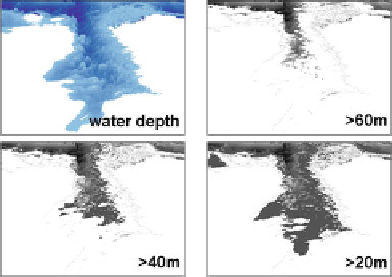Geoscience Reference
In-Depth Information
high organic content of the surface sediments of the soft bottoms increases anoxia
total carbon content of the surface soft sediments of the eastern Gulf of Finland
to be normally above 4% and occasionally up to 6% or more. New, still unpub-
lished studies in the same area have revealed areas with surface TC concentrations
of more than 10% (Vallius, in preparation). As there is virtually no oxygen exchange
between the sea surface and the near-bottom water, because of the strong stratifica-
tion of the water column, the periods of anoxic bottom waters remain for quite long
times. Only occasionally, for example during strong winter storms, at least the shal-
lower bottoms are periodically oxidized. In such cases, these bottoms are oxidized
during spring for a short period, in order to be reduced again after the spring diatom
to break down. The periods of oxic conditions are usually too short for most benthic
fauna to be able to colonize the bottoms. The spring blooms are usually followed by
a short period of less accumulation, to be followed by cyanobacterial blooms during
of accumulation in autumn; most of the organic matter is, however, accumulated
During the second half of the past century, the Gulf of Finland turned into a
badly eutrophic water body. This has through the process explained above involved
regularly repeated anoxic conditions, first in the deeper basins, but later also in shal-
anoxia have largely extended through the last decades. Seafloor anoxia is a harm-
ful condition at least for benthic animals as they cannot survive in such conditions;
only anaerobic bacteria can survive and often they build up mats like carpets on
nutrient-loaded seafloor sediments, which additionally increases eutrophication (i.e.
internal loading). Unfortunately, the process goes on for a long period of time even
if external phosphorus load is radically decreased. This has during the last decades
been seen as extensive mid-summer blooms of harmful blue-green algae in the sea
areas.
Fig. 17.4
Bathymetry of the
Gulf of Finland as seen from
east and areas of > 60 m, >
40 m and > 20 m water
depth

